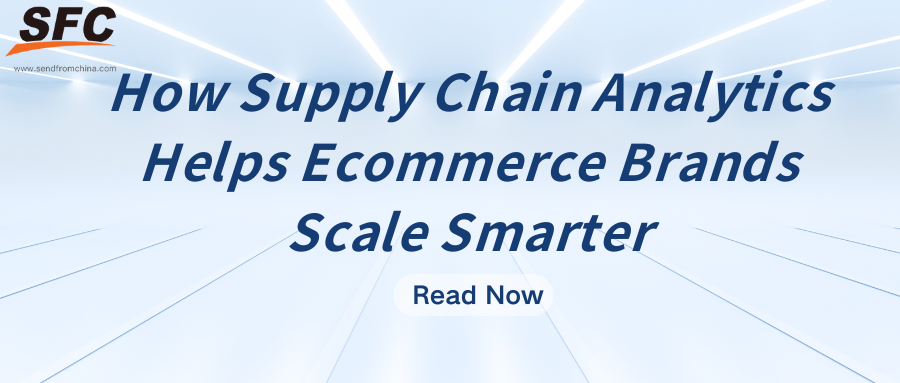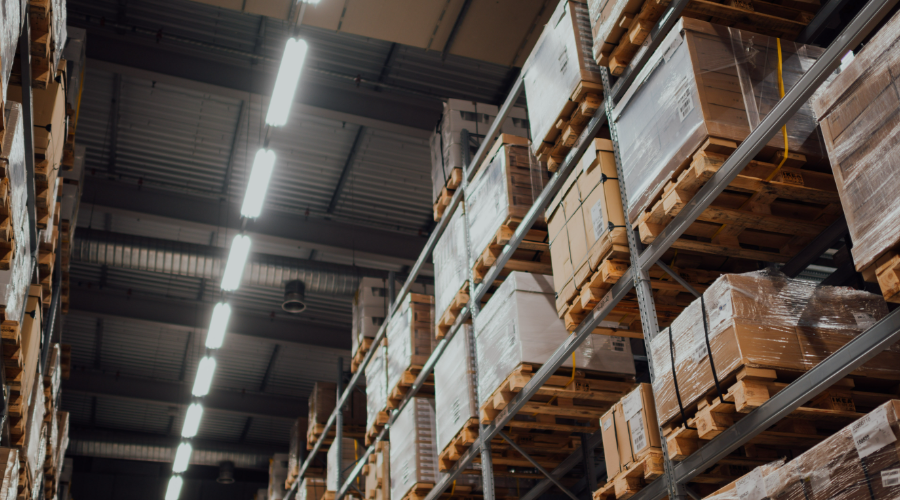Table of Contents
Get Custom eCommerce Fulfillment Service
Book a Meeting
How Supply Chain Analytics Helps Ecommerce Brands Scale Smarter
Time: Nov 03,2025 Author: SFC Source: www.sendfromchina.com
In the fast-moving world of online retail, logistics and supply-chain decisions can mean the difference between scaling profitably and struggling with hidden costs. Here we unpack the fundamentals of supply-chain analytics, why it matters for ecommerce brands, the types of analytics available, how you build a roadmap, and – finally – how SendFromChina helps you cut costs and scale faster through smart analytics.

1. What is supply chain analytics?
At its core, supply-chain analytics refers to the use of data, statistical methods, and software tools to examine everything that goes on in a supply chain—from procurement of raw materials (or finished goods) through manufacturing, warehousing, fulfillment, transport and return/after-sales.
To break it down:
You collect measurements and data points (for example: lead-time from supplier X, inventory days on hand for SKU Y, warehouse picking error rate).You transform those into metrics (e.g., “out of stock bounce rate”, “perfect-order rate”) that can be tracked.
You use analytics to ask why things are happening (diagnostic), what might happen (predictive) or what to do about it (prescriptive/cognitive).
For an ecommerce business, analytics helps you get ‘visibility’ of your end-to-end flow, identify weak links or bottlenecks, and make decisions based on data rather than gut-feel.
2. Why supply chain data analytics is crucial for ecommerce businesses
Ecommerce businesses operate in a highly dynamic environment: rapid fluctuations in demand, multiple sales channels, global sourcing, increasingly demanding customers (speed, transparency), and logistics costs that can eat margins quickly. In this setting, analytics are not optional—they are a differentiator.

Here are key reasons why:
Demand predictability & inventory management
When you sell online, you have rich data flowing: website traffic, conversion rates, purchase history, returns, channel performance. Analytics allows you to forecast demand more accurately, avoid stockouts and overstocking. For example, one blog notes that around USD 163 billion of inventory is lost annually in some sectors due to over-production or expiry. For an ecommerce brand that sources globally, the cost of a mis-forecast is amplified by long lead times, shipping and customs. Analytics helps you reduce that risk.Cost control & margin protection
Logistics, warehousing, shipping, returns—all carry cost. Without visibility you may be paying more than you realise: for slow-moving SKUs, inflated inventory holding, inefficient carrier routes or under-utilised warehouses. Analytics shines a light on where costs are hidden. For example: if you know that SKU ABC is sitting in region A warehouse with low turnover, you might choose to move inventory or reduce safety stock there.Customer experience and retention
In ecommerce, customer expectations are rising: faster delivery, transparency (where’s my order?), fewer errors. Analytics of your fulfilment performance (on-time delivery, perfect order, damage rates) helps you identify problems and fix them before they erode customer trust. A supply-chain breakdown is no longer just an operations issue—it directly impacts brand reputation.Agility in global sourcing and logistics
If you source from China and ship globally, your supply chain may span manufacturing, export / import processes, sea/air freight, last-mile delivery. The number of variables is large. Analytics helps you model scenarios, anticipate risks (e.g., shipping cost spikes, port delays, supplier shortfall) and respond rather than react.Data-driven decision-making as a competitive edge
Many ecommerce companies still rely on manual spreadsheets, siloed data or delayed reports. Those that harness supply-chain analytics gain a competitive edge: faster decisions, better alignment between operations + commercial teams (merchandising, marketing, logistics), and ability to scale more confidently.
3. Types of supply chain analytics
Analytics comes in different “flavours” and maturity levels. Understanding these types helps you determine where you are now, and what to aim for. According to several sources:
Descriptive analytics
This is the baseline: What happened? Examples: monthly inventory turnover, fill rate, total logistics cost, lead times from supplier A. These analytics are typically dashboards, reports, and are good for monitoring performance.Diagnostic analytics
Here the question becomes: Why did it happen? For example: why did lead time from Vendor X increase by 20 % this quarter? Why did that warehouse picking error jump? These analytics dig into root cause.Predictive analytics
Moving forward: What might happen? For instance: forecasting SKU demand for next quarter, predicting stock-outs, forecasting shipping cost changes or disruption risk.Prescriptive analytics
Here we ask: What should we do? Based on predictions and diagnostics, prescriptive analytics offer recommendations: for example, shift 20 % of your supply from port A to port B, or maintain a safety-stock buffer of X days for SKU Y in region Z.Cognitive analytics (or advanced analytics)
The most advanced level: with AI/ML, real-time data, “self-learning” supply chains. For large ecommerce operations, cognitive analytics can process unstructured data (e.g., social sentiment, shipping-lane disruptions, IoT sensors) and feed automated decisions.How these fit together
Think of it as a maturity ladder:
Descriptive → understand the past
Diagnostic → analyse the causes
Predictive → forecast the future
Prescriptive → recommend actions
Cognitive → automate decisions and learn continuously
For many ecommerce brands, the first two or three are where the value is strongest. The later levels bring competitive advantage but also require more data, tools, and organisational maturity.
4. How to build your supply chain analytics roadmap
If you’re an ecommerce brand, how do you go about building a roadmap for supply-chain analytics? Below is a structured approach.

Step 1: Align with business objectives
Start by clarifying what your business is trying to achieve. Example questions:
Are you expanding into new markets and need faster fulfilment?
Is your logistics cost growing faster than sales?
Do you have frequent stock-outs or returns?
Is your customer satisfaction impacted by logistics? These objectives will anchor what analytics you need and how you prioritise.Step 2: Inventory and assess your data sources
Evaluate what data you currently collect. Some examples:
Procurement data: supplier lead times, price, quality metrics
Fulfilment/shipping: transit times, carrier performance, cost per parcel
Customer data: returns, shipping-related complaints, geography
External data: freight indices, port delays, customs clearance times As per industry sources, many firms struggle because of data silos, inconsistent formats, or missing data. Ensure you have breadth (across functions) and depth (good quality, consistent data).Step 3: Define KPIs and metrics
Based on your objectives, define the key metrics you will track. Examples for ecommerce:
Out-of-stock rate
Freight cost per unit
Perfect order rate (on-time, correct, no damage)
Inventory days on hand
Cost of goods sold (COGS) including logistics
Customer-support cases for “Where is my order?” (WISMO) It’s important that metrics are both meaningful (linked to business outcomes) and measurable (data is available).Step 4: Map analytics maturity & build layers
Decide where you are now, and where you want to go. Typical layering:
Basic: Descriptive dashboards and reports
Intermediate: Diagnostic and predictive analytics for key pain‐points
Advanced: Prescriptive/cognitive analytics for full optimisation Set a timeline: e.g., next 6 months focus on inventory & fulfilment dashboards; next 12-24 months build predictive forecasting; in 2-3 years implement prescriptive analytics. Also consider technology: what tools, platforms, training you need.Step 5: Data infrastructure & integration
Analytics won’t work if your data is fragmented. You’ll likely need:
Data warehouse or data lake to centralise data
Data-cleaning routines to ensure quality
Data governance to maintain consistency Industry thought-leaders highlight that data integration is a top barrier.Step 6: Choose tools & build capabilities
Select appropriate analytics tools whether BI dashboards (e.g., Tableau, PowerBI), specialised supply-chain analytics platforms, or advanced ML frameworks. Also build internal capability: analytics team, supply-chain specialists who understand the operations + data scientists/analysts. Remember: data alone isn’t enough—you need people who interpret and act on insights.Step 7: Pilot, measure, refine
Pick a use-case (e.g., reducing lead time for major SKU, optimising inventory in one region) and run a pilot. Measure impact (cost reduction, lead-time improvement). Use findings to refine your analytics models, data flows and organisational processes.
Analytics is iterative. Your roadmap should allow for continuous improvement, not just a one-time project.
Step 8: Scale & embed analytics into operations
Once you have successful pilots, roll out across other SKUs, regions or business units. Embed analytics into daily operations: dashboards that operations teams review, alerts when metrics breach thresholds, decision-making tied to analytics rather than intuition.
Ensure the analytics capability becomes part of your supply-chain DNA.
Step 9: Monitor, govern, refresh
Supply-chain dynamics shift: trade lanes change, customer expectations evolve, logistics costs fluctuate. So your analytics roadmap should include regular reviews: Are metrics still relevant? Data still accurate? Models still valid? Governance ensures you don’t drift into outdated practice.5. Supply chain analytics tips and best practices
Here are some practical tips and proven best practices (drawn from industry research and real-world deployments) that ecommerce logistics teams should keep in mind.

Tip 1: Start small, deliver value quickly
Rather than waiting to build a full analytics platform, pick a high-impact use-case and deliver something tangible in 3-6 months (for example: reducing fulfilment cost for one channel). Early wins build momentum and buy-in.
Tip 2: Focus on critical metrics
Not all metrics are equally valuable. Focus on those that impact your business most (e.g., cost per unit shipped, perfect-order rate, inventory days). Overloading dashboards with low-value metrics dilutes attention.
Tip 3: Data quality cannot be ignored
Poor data quality (missing values, inconsistent formats, delayed updates) undermines analytics. Set up data-cleansing, establish clear definitions (e.g., what counts as ‘on-time delivery’), and align across teams.
Tip 4: Break down silos and integrate cross-functional data
Often supply-chain data lives in multiple systems: procurement, operations, fulfilment, customer service. Analytics often fails when these are not connected. Integration enables richer insights (e.g., linking customer support “where is my order” cases with freight-delay data).
Tip 5: Blend human insight with analytics
While advanced models and ML are powerful, human domain-knowledge remains critical. Analysts should collaborate with operations and logistics teams to interpret results and decide on actions. The “human fingerprint” ensures insights are grounded in reality.
Tip 6: Use scenario modelling for risk & disruption
Ecommerce supply chains face risks: port congestion, shipping cost spikes, supplier disruption. Use predictive and prescriptive analytics to run “what-if” scenarios (e.g., if air-freight cost increases 30 %, what is the impact on margin?). Prepare mitigation plans.
Tip 7: Visualise insights in intuitive dashboards
Data is only useful if stakeholders understand it. Use clear visualisations, traffic-light alerts, executive summaries. For non-analytics teams (e.g., operations or commercial), simplicity wins.
Tip 8: Continually review and improve
What works today might not tomorrow. Analytics models need to be refreshed (new data, changed business conditions). Set periodic reviews of your analytics roadmap, tools, metrics and staffing to stay agile.
Tip 9: Ensure scalability and flexibility
If your ecommerce business scales (new markets, more SKUs, more fulfilment centres), your analytics capability must scale too. Choose tools and platforms that can handle more data, more complexity, and support more advanced analytics over time.
Tip 10: Partner with logistics experts
Especially when sourcing globally, working with experienced 3PL/fulfillment partners brings in data and operational intelligence you might not have internally. Their visibility on shipping, customs, fulfilment and regional logistics strengthens your analytics foundation.
6. Cut costs and scale faster with SFC’s smart supply chain analytics
At SendFromChina (SFC), we understand the unique challenges that ecommerce brands sourcing from China and selling globally face. Our value proposition is built around helping you leverage supply-chain analytics to reduce cost, improve speed and scale your operations. Here’s how we apply that in practice.
Global sourcing visibility + data capture
From China manufacturing, consolidation, export handling, ocean or air freight, customs clearance to overseas fulfilment centres and last-mile delivery — SFC captures logistics data across this entire chain. That data gives you insights into supplier lead-times, transit time variability, cost drivers, customs dwell time, fulfilment centre handling and more.
This rich dataset forms the backbone of your analytics.
Inventory placement & multi-warehouse optimisation
Ecommerce brands need to decide where to hold inventory (China forward stock, overseas fulfilment, cross-dock, direct-ship). With SFC’s analytics, we help model total landed cost—including shipping, duties, holding cost and fulfilment cost—to determine optimal placement. By shifting inventory intelligently, brands can reduce shipping cost, shorten delivery times and improve customer satisfaction.Freight cost control & carrier performance
SFC tracks freight cost by mode (sea, air, express), by lane, by carrier. With analytics we identify cost spikes (e.g., surcharges, detention), flag under-performing carriers (delays, damage rates) and recommend corrective actions such as alternate carriers or routing.
Armed with that insight, ecommerce brands reduce logistics cost and protect margins.
Fulfilment performance
We monitor fulfilment centre KPIs: picking/packing error rate, shipping cut-off adherence. With analytics we identify bottlenecks (e.g., certain SKUs consistently delayed, certain regions high return rate) and address root causes.
The result: improved perfect-order rate, fewer customer complaints, better brand experience.
Demand forecasting & supply-chain agility
Using historical data, seasonality models and combining with our Chinese sourcing expertise, we help ecommerce brands forecast demand and supply requirements. This reduces safety-stock overuse, avoids stock-outs and shortens cash-to-cash cycle.
In fast-moving ecommerce, that agility is a key competitive advantage.
Scenario-based planning for scale
Planning to launch into new markets (Europe, North America, Australia)? SFC supports scenario modelling: what if sea-freight cost rises 20 %? What if transit delay increases 10 days? What if fulfilment centre handling time doubles during peak season?
With those insights you’re not caught off guard — you’re prepared.
Transparent dashboards and operational reporting
SFC provides clients with dashboards showing key logistics metrics, alerts when thresholds are breached (e.g., lead-time > target, carrier delay > X days). These dashboards empower ecommerce brands to act swiftly rather than wait for a monthly report.
Cost savings and scaling faster
By applying analytics across sourcing, freight, warehousing and fulfilment, SFC helps ecommerce brands:
Reduce inventory holding cost
Reduce freight cost per unit
Improve delivery times and customer satisfaction
Scale without proportionally increasing logistics complexity
Turn logistics from a cost-centre into a growth-enabler
7. Conclusion
In today’s ecommerce landscape, supply-chain analytics isn’t just a nice add-on — it’s a strategic necessity. From demand forecasting, inventory optimisation, cost control, to customer experience, the benefits are clear. By understanding the types of analytics (descriptive through cognitive), building a structured roadmap, following best practices and partnering with a logistics expert like SendFromChina, you give your business a real head-start. The divide between “logistics drag” and “logistics engine” is often determined by how well you use data — so start early, start smart, and build your analytics muscle.
8. FAQs
Q1: What is the difference between supply-chain metrics and supply-chain analytics?
Answer: Metrics are the numbers you measure (e.g., inventory days, shipping cost per unit). Analytics is what you do with them (e.g., diagnose trends, forecast future demand, prescribe changes).Q2: My ecommerce business is small. Do I really need supply-chain analytics?
Answer: Yes — even smaller businesses can benefit by starting modestly (descriptive dashboards, key metrics) and then growing. Early visibility helps identify issues before they become major cost drains.Q3: How much data do I need to start supply-chain analytics?
Answer: Enough to measure your key business processes (inventory, sourcing lead-time, fulfilment performance). Quality is often more important than volume. Clean, consistent data is a better foundation than massive but messy datasets.Q4: What is the most common mistake companies make when building supply-chain analytics?
Answer: One frequent mistake is building the analytics platform first without aligning to business objectives. Another is neglecting data integration (silos), resulting in dashboards that look nice but don’t drive action.Q5: How quickly can I expect to see results from supply-chain analytics?
Answer: If you prioritise a high-impact use-case and run a pilot within 3-6 months, you can see meaningful improvements (reduced cost, improved lead-time, better fulfilment). Full rollout and maturity (predictive/prescriptive) may take 12-24 months or more. Post Views:19
Post Views:19
Copyright statement: The copyright of this article belongs to the original author. Please indicate the source for reprinting.
Previous Post
Next Post
Logistics Risk Management Explained: Types, Benefits & Practical Tips
TAGS
Hot Research
Get Custom eCommerce Fulfillment Service
Book a Meeting
Get a Custom China Fulfillment Solution with FREE Storage for 30 Days
 Want to know about our services, fees or receive a custom quote?
Want to know about our services, fees or receive a custom quote?
 Please fill out the form on the right and we will get back to you within a business day.
Please fill out the form on the right and we will get back to you within a business day.
 The more information you provide, the better our initial response
will be.
The more information you provide, the better our initial response
will be.





 TAGS:
TAGS: